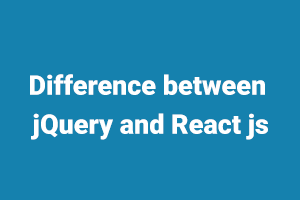jQuery and React are very popular JavaScript libraries producing almost the same results even though they use different techniques. jQuery is a utility library enabling the developers to build web apps effortlessly using JavaScript, whereas React js library allows embedding HTML within JavaScript.
What is jQuery?
jQuery is a ‘lightweight’ JavaScript library. When it was released back in 2006, JavaScript was not widely used. But jQuery nowadays has revolutionized the industry, by wrapping a thousand lines of JavaScript code into methods that you can call with a single line of code. We can use the phrase “write less, do more” to define jQuery.
jQuery Features:
- jQuery supports DOM manipulation.
- It also wraps a number of HTML event methods.
- We can easily use the effects and animation with jQuery.
- jQuery is a library full of different utilities.
- With jQuery, we need to write fewer number Lines of code because we can wrap up all methods in it.
What is React?
React is an open-source, declarative, efficient, and very flexible JavaScript library. This library was created by Facebook in 2011, necessarily for the purpose of building interactive UI elements.
React provides reusable library code which shortens the total development time and also shortens the scope of errors. With React js, developers can build large-scale, dynamic-looking single-page applications.
React Features:
- Developers can directly access React code snippets and components for creating specific parts of a User Interface.
- It also provides a Virtual DOM for improving the performance of the website.
- It is an open-source library.
- Developers can use the react library for addressing the UI functions.
- The React js library is growing exponentially.
jQuery vs React js
| jQuery | React js |
| jQuery directly interacts with DOM which results in low performance. | React js uses the virtual DOM for high speed, better performance, and UI. |
| jQuery is not suitable for large applications. It generates complex code and traditional DOM doesn’t support complex codes either. | The components-based architecture and virtual DOM manipulation in React make it suitable for building large-sized applications. |
| jQuery and React are very similar when it comes to ease of use, however, their objectives are different. With the help of jQuery, we can accomplish the application effortlessly, because there is a need to write less code in jQuery. It is helpful for some projects, like building a simple website with animated menus, triggering events with a button and images. | React is a UI-specific library that developers can use in building web apps with complicated functions and a variety of views. |
| jQuery is 7 years older than React. But the number of NPM packages in jQuery is significantly low. This might be because NPM came in 2019 when a large chunk of developers had already shifted from jQuery to other platforms. | React contains a number of NPM packages, which are significantly higher than jQuery. |
| The size of the jQuery library is small which takes less time to load, which makes it effective. It is 75kb which is 18% lower than the react js. | The React library size is about 95KB which is large in size comparative to jQuery, which becomes the reason for frequent protest from React developers. It loads almost 20% less in terms of speed on mobile. |
If you have skills in PHP programming and you want to enhance your career in this field, a PHP certification from StudySection can help you reach your desired goals. Both beginner level and expert level PHP Certification Exams are offered by StudySection along with other programming certification exams.




